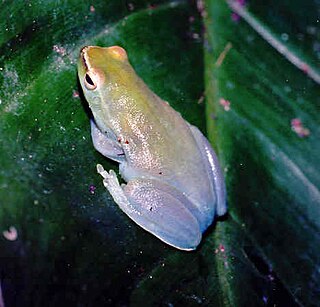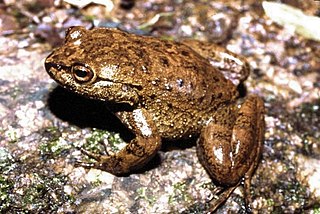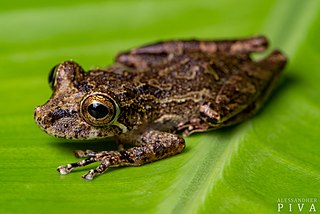
The Crato Formation is a geologic formation of Early Cretaceous (Aptian) age in northeastern Brazil's Araripe Basin. It is an important Lagerstätte for palaeontologists. The strata were laid down mostly during the Aptian age, about 113 million years ago. It thought to have been deposited in a semi-arid lacustrine wetland environment.

Hyphessobrycon is a genus of freshwater fish in the family Characidae. These species are among the fishes known as tetras. The genus is distributed in the Neotropical realm from southern Mexico to Río de la Plata in Argentina. Many of these species are native to South America; about six species are from Central America and a single species, H. compressus is from southern Mexico.

Sphaenorhynchus is a genus of frogs in the family Hylidae. They are also known as lime treefrogs or hatchet-faced treefrogs. They are found in the Amazon and Orinoco River basins of South America, the Guianas, Trinidad, and southern and eastern Brazil. The majority of the species are associated with the Atlantic Forest domain in Brazil.

The canebrake tree frogs are a frog genus Aplastodiscus. They are in the family Hylidae. Residing primarily in southeast regions of Brazil near the Atlantic coast. The exception is the Aplastodiscus perviridis which is found mostly in Brazil, but has also been documented being in Argentina, and might reside in Paraguay. The major revision of the Hylidae genus expanded it to include 12 more species originally from Hyla. Before the revision there were only 2 species. There are currently 16 described species with the most recent addition Aplastodiscus heterophonicus being described in 2021.

Physalaemus is a large genus of leptodactylid frogs. These frogs, sometimes known as dwarf frogs or foam frogs, are found in South America. It is very similar to Leptodactylus, a close relative, and indeed the recently described Leptodactylus lauramiriamae is in some aspects intermediate between them.

Adenomera is a genus of leptodactylid frogs, sometimes known as tropical bullfrogs, found in South America east of the Andes. The genus was until recently considered a synonym of Leptodactylus.

Leptodactylus is a genus of leptodactylid frogs. It includes the species commonly called ditch frogs or white-lipped frogs. It is very similar to Physalaemus, a close relative, and indeed the 2005 described Leptodactylus lauramiriamae is in some aspects intermediate between them. The name means ‘slender finger’, from leptos and the Greek daktylos.

Boana is a genus of frogs in the family Hylidae. They are commonly known as gladiator frogs, gladiator treefrogs or Wagler Neotropical treefrogs. These frogs are distributed in the tropical Central and South America from Nicaragua to Argentina, as well as in the Caribbean.

Aplastodiscus albosignatus, also known as the Bocaina treefrog, is a species of frog in the family Hylidae. It is endemic to Brazil. Its natural habitats are subtropical or tropical moist lowland forests, subtropical or tropical moist montane forests, and rivers. It is threatened by habitat loss.

Aplastodiscus arildae is a species of frog in the family Hylidae. It is endemic to Brazil. Its natural habitats are subtropical or tropical moist lowland forests and rivers.
Aplastodiscus flumineus is a species of frog in the family Hylidae. It is endemic to Brazil. Its natural habitats are subtropical or tropical moist montane forests and rivers. It is threatened by habitat loss.
Phantasmarana bocainensis, also known as Bocaina big tooth frog is a species of frog in the family Hylodidae. It is endemic to Brazil and only known from its type locality in the Serra da Bocaina National Park, São Paulo state.

Odontophrynus is a genus of frogs in the family Odontophrynidae. They are found in southern and eastern South America. They are sometimes known as the escuerzos.

Events in the year 1907 in Brazil.

Events in the year 1890 in Brazil.

Aplastodiscus lutzorum is a species of frogs in the family Hylidae. It is endemic to the Cerrado region in Brazil and is known from the Federal District and the adjacent eastern Goiás and northwestern Minas Gerais states. The specific name lutzorum honors Adolfo and Bertha Lutz, Brazilian zoologists.
Coendou speratus, known locally as coandumirim and commonly as the dwarf porcupine, is small porcupine of the Coendou genus found in northeastern Brazil. This small porcupine has a long tail and a spiny appearance as its dorsal fur is not long. Its dorsal colouring is blackish which contrasts with the brownish tips of its quills. It is distinguished from Coendou nycthemera by its tricolored quills whereas nycthemera is bicoloured.

Phantasmarana is a genus of frogs in the family Hylodidae. The genus is endemic to the Atlantic Forest of southeastern Brazil.

Ololygon is a genus of frogs in the family Hylidae. The majority of species in it are endemic to the Atlantic Forest of eastern Brazil, although the range of some species, including Ololygon aromothyella and Ololygon berthae, is known to extend south to northeastern Argentina, southern Paraguay, and Uruguay.














